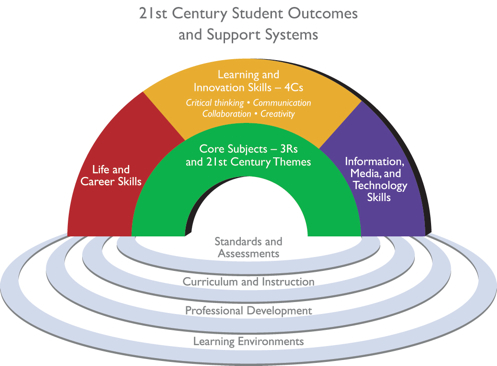Instructional Technology Leadership in the Virtual School
by Mark Sivy
In today’s virtual school learning environment, educational leaders play a crucial role in the ability of the school’s community to adopt and adapt to the purposeful use of technology (Timperly, Wilson, Barrar, & Fung, 2007; Wang, 2009). An increased responsibility has been placed upon leaders by the 21st Century Skills movement, which centers on ensuring that students acquire the academic, cognitive and technological skills necessary for a post-industrialist globalized society. In relation to this, Jones, Fox, and Levin (2011) highlighted four educational strategies that are necessary to prepare students for life in the new world setting: building a 21st century infrastructure for equity, innovation, and improvement; supporting educator effectiveness; developing and scaling innovative learning models; and preparing all students for college and 21st century careers. For virtual school leaders, these strategies involve tasks such as maintaining a required technology infrastructure, facilitating educational communities of practice, supporting the online blended learning, and enabling collaborative learning.
Technology Infrastructure
Without an adequate technology infrastructure, the intentional use of technology for learning could be an exercise in futility and frustration. A virtual school senior leader must plan for and fund technology infrastructure, including hardware, software, online systems and digital connectivity. This requires having technical staff that can provide services ranging from system repair to individual user assistance. The leader must also safeguard that this technology infrastructure parallels the learning infrastructure by ensuring that the use of technology helps in establishing, maintaining, and supporting learning contexts, learning content, and a facilitative school culture (Jameson, 2013).
Teacher and Staff Professional Development
Senior leaders are responsible for developing the professional capacity of their school in relation to the use of technology. School leaders must acknowledge that this preparation should incorporate initial training, ongoing professional development and communities of practice, and developmental checkpoints. Additionally, these development opportunities must ensure that pedagogical practices are aligned with and make meaningful use of the instructional technology.
School Senior Leader Professional Development
It’s not only important for leaders to be aware of the implications and responsibilities associated with good teacher professional development, but leaders themselves must also be sufficiently familiar with online learning technologies. Whale (2003) found that administrators who had received technology training were better at optimizing the use of technology for learning and were stronger leaders in general. This development is best done over time since it involves not only the acquisition of skills, but also the changing of attitudes and beliefs with respect to technology’s role in educational processes. Macaulay and Wizer (2010) determined that senior leaders move through a hierarchy of skills that develop gradually based upon experience and that training should occur accordingly and in support of these stages.
Technology Planning
 In turn, a school administrator who is properly trained should be able to effectively create both short-term and long-term plans for the implementation of instructional technologies, online learning, and associated learning models. These plans would incorporate sequenced and paced rollouts that are scalable, adaptive, and sustainable. Jones, Fox, and Levin (2011) stated that successful planning will help to address education priorities, yet allow for flexibility and adaptability. These practices may also involve effecting or altering policy in ways that will build the necessary organizational capacities over time.
In turn, a school administrator who is properly trained should be able to effectively create both short-term and long-term plans for the implementation of instructional technologies, online learning, and associated learning models. These plans would incorporate sequenced and paced rollouts that are scalable, adaptive, and sustainable. Jones, Fox, and Levin (2011) stated that successful planning will help to address education priorities, yet allow for flexibility and adaptability. These practices may also involve effecting or altering policy in ways that will build the necessary organizational capacities over time.
Reflection Point – “It is not about the technology; it’s about sharing knowledge and information, communicating efficiently, building learning communities and creating a culture of professionalism in schools. These are the key responsibilities of all educational leaders”. ~ Marion Ginapolis
References
Jameson, J. (2013). e-Leadership in higher education: The fifth “age” of educational technology research. British Journal of Educational Technology, 44, 889-915.
Jones, R. Fox, C., & Levin, D. (2011). State Technology Leadership Essential for 21st Century Learning, Annual report SETDA.
Macaulay, L. & Wizer, D. (2010). Elementary principals as technology instructional leaders. Proceedings of World Conference on E-Learning in Corporate, Government, Healthcare, and Higher Education 2010, 2008-2017.
Timperly, H. Wilson, A., Barrar, H. & Fung, I. (2007). Teacher professional learning and development. Best evidence synthesis iteration [BES]. Wellington, New Zealand: Ministry of Education.
Wang, C. (2009). Technology leadership among school principals: A technology coordinators perspective. Asian Social Science, 6(1), 51-54.
Whale, D. (2003). The new technology standards for school administrators: Findings from the first large-scale survey of high school principals. Connections, 5.


